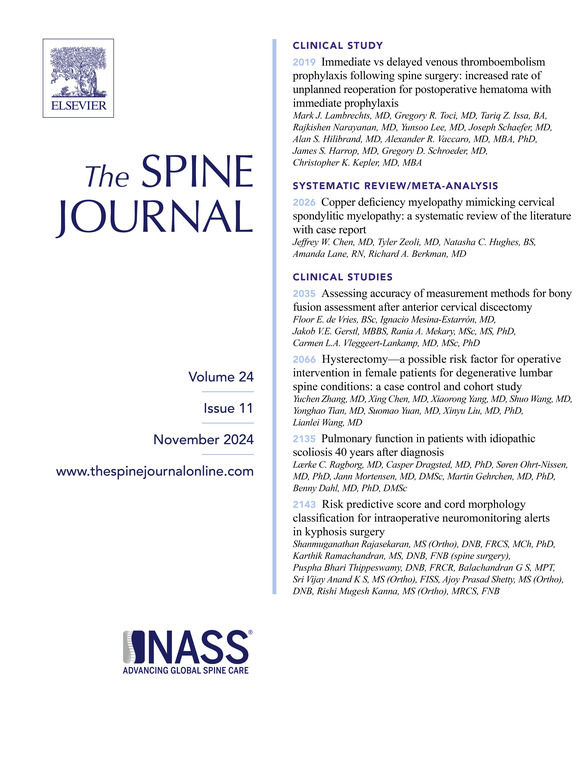Importance of gap evaluation in the ossification of posterior longitudinal ligament lesions using 3-dimensional computed tomography
IF 4.7
1区 医学
Q1 CLINICAL NEUROLOGY
引用次数: 0
Abstract
BACKGROUND CONTEXT
Evaluating the gaps within the ossification of the posterior longitudinal ligament (OPLL) lesions, which may contribute to neurological symptoms, using conventional imaging techniques is challenging.
OBJECTIVE
This study aimed to investigate the importance of evaluating gaps using 3-dimensional computed tomography (3D-CT) and their association with the occurrence of magnetic resonance imaging (MRI) T2 high intensity in the spinal cord.
STUDY DESIGN/SETTING
Retrospective cohort study.
PATIENT SAMPLE
Retrospective analysis of 116 patients diagnosed with cervical OPLL.
OUTCOME MEASURES
Presence of gaps in OPLL, presence of T2 high intensity in the cervical spinal cord, and OPLL thickness were evaluated.
METHODS
Lateral X-ray, CT, and reconstructed 3D-CT images were reviewed to assess lesion characteristics and the presence of gaps. MRI was used to evaluate the change in spinal cord signal intensity. The relationship among gap presence, lesion morphology, and MRI T2 high intensity in the spinal cord was examined.
RESULTS
A significant difference in gap detection accuracy was observed between CT and 3D-CT (p=.0054). CT demonstrated false-positive results in the detection of gaps as compared with 3D-CT. The presence of gaps was significantly associated with an increased likelihood of MRI T2 high intensity in the spinal cord (p=.037). Patients with thicker lesions and smaller space available for the spinal cord (SAC) were more likely to exhibit T2 high intensity. Meanwhile, patients with gaps cooccurring with T2 high intensity exhibited significantly thinner lesions (p=.011) and larger SACs (p=.0002). Patients with gaps had a significantly lower JOA scores (p=.0035), which indicates that patient with gaps are likely to exhibit more severe clinical neurological symptoms.
CONCLUSIONS
3D-CT showed superiority in accurately identifying gaps within OPLL lesions, while CT demonstrated false-positive results in the detection of gaps. Furthermore, the gap presence was a risk factor for MRI T2 high intensity in the spinal cord, independent of lesion thickness. In addition, gaps are related to more severe clinical symptoms. This study highlighted the importance of evaluating gaps within OPLL lesions using 3D-CT to clarify neurological pathogenesis.
利用三维计算机断层扫描评估后纵韧带病变骨化间隙的重要性。
本研究旨在探讨使用三维计算机断层扫描(3D-CT)评估间隙的重要性及其与脊髓磁共振成像(MRI)T2高强度的关联。研究设计/背景回顾性队列研究.患者样本回顾性分析了116例确诊为颈椎OPLL的患者.结果测量评估了OPLL中是否存在间隙、颈椎脊髓中是否存在T2高强度以及OPLL的厚度.方法回顾侧位X光片、CT和重建的3D-CT图像,以评估病变特征和间隙的存在。核磁共振成像用于评估脊髓信号强度的变化。结果观察到 CT 和 3D-CT 在间隙检测准确性上存在显著差异(p = 0.0054)。与 3D-CT 相比,CT 在检测间隙方面显示出假阳性结果。间隙的存在与脊髓 MRI T2 高强度的可能性增加明显相关(p = 0.037)。病变较厚且脊髓可用空间较小的患者(SAC)更有可能出现 T2 高强度。与此同时,与 T2 高强度同时出现间隙的患者的病灶明显较薄(p = 0.011),SAC 较大(p = 0.0002)。有间隙的患者 JOA 评分明显较低(p = 0.0035),这表明有间隙的患者可能表现出更严重的临床神经症状。此外,间隙的存在是脊髓 MRI T2 高强度的危险因素,与病变厚度无关。此外,间隙还与更严重的临床症状有关。这项研究强调了使用 3D-CT 评估 OPLL 病变内间隙对明确神经系统发病机制的重要性。
本文章由计算机程序翻译,如有差异,请以英文原文为准。
求助全文
约1分钟内获得全文
求助全文
来源期刊

Spine Journal
医学-临床神经学
CiteScore
8.20
自引率
6.70%
发文量
680
审稿时长
13.1 weeks
期刊介绍:
The Spine Journal, the official journal of the North American Spine Society, is an international and multidisciplinary journal that publishes original, peer-reviewed articles on research and treatment related to the spine and spine care, including basic science and clinical investigations. It is a condition of publication that manuscripts submitted to The Spine Journal have not been published, and will not be simultaneously submitted or published elsewhere. The Spine Journal also publishes major reviews of specific topics by acknowledged authorities, technical notes, teaching editorials, and other special features, Letters to the Editor-in-Chief are encouraged.
 求助内容:
求助内容: 应助结果提醒方式:
应助结果提醒方式:


